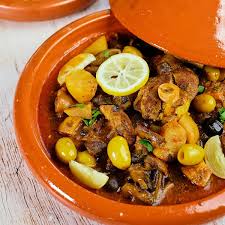Exploring the Flavours of Morocco: The Exquisite Tagine Dish
One cannot delve into Moroccan cuisine without encountering the tantalising aroma and taste of tagine. This iconic dish, named after the earthenware pot in which it is cooked, embodies the essence of Moroccan culinary tradition.
The Art of Tagine Cooking
Tagine refers to both the dish itself and the cooking vessel with a conical lid that helps retain moisture and infuse flavours. Traditionally prepared over charcoal or low heat, tagines are a slow-cooked marvel where meats, vegetables, fruits, and a myriad of spices meld together to create a symphony of tastes.
A Symphony of Flavours
The beauty of tagine lies in its versatility. From succulent lamb or chicken tagines with apricots and almonds to vegetarian versions bursting with chickpeas, sweet potatoes, and aromatic herbs—the possibilities are endless. Each bite offers a harmonious blend of sweet, savoury, and spicy notes that dance on your palate.
The Essence of Moroccan Hospitality
In Morocco, sharing a tagine is not just about enjoying a meal; it is a symbol of hospitality and togetherness. Families and friends gather around a steaming tagine pot placed at the centre of the table, using crusty bread to scoop up tender morsels and savour every mouthful.
Bringing Morocco Into Your Home
While nothing quite compares to savouring an authentic tagine in the bustling markets or riads of Morocco, you can recreate this culinary masterpiece in your own kitchen. With simple ingredients and a bit of patience, you can transport yourself to the vibrant streets of Marrakech or Fes with each delectable bite.
Experience Tagine Magic
Whether you’re a culinary enthusiast seeking new flavours or an adventurer longing for an authentic taste of Morocco, exploring the world of tagines is sure to delight your senses. Let this iconic dish be your gateway to the rich tapestry of Moroccan cuisine—one fragrant spoonful at a time.
Discover the Allure of Tagine: 7 Reasons to Savour This Moroccan Delight
- 1. Bursting with exotic flavours and aromatic spices.
- 2. Offers a versatile range of ingredient options for both meat lovers and vegetarians.
- 3. Slow-cooking process tenderizes meat to perfection, ensuring melt-in-your-mouth goodness.
- 4. Conical lid traps steam, preserving moisture and intensifying flavours.
- 5. Promotes communal dining experience, perfect for sharing with loved ones.
- 6. Represents the essence of Moroccan culinary heritage and tradition.
- 7. Easy to prepare at home, bringing a taste of Morocco to your kitchen.
Exploring the Drawbacks of Moroccan Tagine: 7 Cons to Consider
- Long cooking time required for traditional preparation
- Specialized equipment (tagine pot) may not be readily available
- Some ingredients used in tagines can be expensive or hard to find
- May not suit individuals with dietary restrictions or preferences (e.g. vegetarian, vegan)
- Rich flavours and spices in tagines may not appeal to everyone’s taste
- Leftovers of tagine dishes sometimes lose their original texture and flavour upon reheating
- Certain versions of tagine recipes can be high in fat content
1. Bursting with exotic flavours and aromatic spices.
Indulge your senses in the culinary delight that is the Moroccan dish tagine, bursting with exotic flavours and aromatic spices. Each mouthful is a symphony of tastes, where the richness of tender meats or vibrant vegetables is complemented by a medley of traditional seasonings like cumin, cinnamon, saffron, and preserved lemons. The fragrant steam that rises from the tagine pot carries with it the essence of Morocco, promising a sensory journey like no other.
2. Offers a versatile range of ingredient options for both meat lovers and vegetarians.
The beauty of the Moroccan dish tagine lies in its ability to cater to a wide range of palates and dietary preferences. With its versatile nature, tagine offers an array of ingredient options that can satisfy both meat lovers and vegetarians alike. From succulent lamb or chicken variations to hearty vegetable-based tagines bursting with flavour, there is something for everyone to savour in this iconic Moroccan dish.
3. Slow-cooking process tenderizes meat to perfection, ensuring melt-in-your-mouth goodness.
The slow-cooking process of preparing a Moroccan tagine is a culinary marvel that works its magic on meat, tenderizing it to perfection. As the dish simmers gently over low heat, the flavours intensify, and the meat becomes incredibly tender, practically melting in your mouth with each savoured bite. This meticulous cooking technique ensures that every morsel of meat in the tagine exudes a succulent and rich texture that truly embodies melt-in-your-mouth goodness.
4. Conical lid traps steam, preserving moisture and intensifying flavours.
The conical lid of a Moroccan tagine serves as a culinary marvel, adept at trapping steam within the earthenware pot. This ingenious design not only preserves the moisture of the ingredients but also works its magic by intensifying the flavours as they mingle and develop during the slow cooking process. As the steam circulates and condenses under the lid, it creates a self-basting effect that ensures every bite of the tagine is infused with rich, aromatic goodness, making each mouthful a delightful journey through layers of taste and texture.
5. Promotes communal dining experience, perfect for sharing with loved ones.
Indulging in a Moroccan tagine not only satisfies your taste buds but also promotes a communal dining experience, making it perfect for sharing with loved ones. Gathering around a steaming tagine pot, each person can savour the rich flavours and fragrant aromas while bonding over this traditional dish. The act of sharing a tagine embodies the spirit of togetherness and hospitality that is deeply ingrained in Moroccan culture, creating memorable moments and strengthening relationships with family and friends.
6. Represents the essence of Moroccan culinary heritage and tradition.
The tagine dish represents the essence of Moroccan culinary heritage and tradition by encapsulating centuries-old cooking techniques, flavour profiles, and communal dining practices unique to the region. As a symbol of Morocco’s rich gastronomic history, the tagine embodies the spirit of sharing meals with loved ones, honouring local ingredients, and celebrating the vibrant culinary tapestry that defines Moroccan cuisine.
7. Easy to prepare at home, bringing a taste of Morocco to your kitchen.
Experience the convenience and joy of preparing a Moroccan tagine in the comfort of your own kitchen. With its simple yet flavourful ingredients and straightforward cooking process, making a tagine at home is a delightful way to bring the essence of Morocco to your dining table. From the tantalising aromas that fill your home to the rich and exotic flavours that transport you to the bustling souks of Marrakech, cooking a tagine is not just a culinary adventure—it’s a journey of taste and tradition right in your own home.
Long cooking time required for traditional preparation
Traditional preparation of Moroccan tagine comes with the con of requiring a significant amount of time for cooking. The slow-cooking method, essential for allowing the flavours to develop and ingredients to tenderize, means that preparing an authentic tagine dish demands patience and foresight. While the wait may seem lengthy, the end result is a culinary masterpiece that captures the essence of Moroccan cuisine in every aromatic bite.
Specialized equipment (tagine pot) may not be readily available
In exploring the culinary world of Moroccan tagine dishes, one potential drawback to consider is the requirement for specialized equipment, such as a tagine pot, which may not be readily available in every kitchen. The unique design of the tagine pot, with its conical lid that helps circulate and retain moisture during cooking, plays a crucial role in achieving the dish’s characteristic flavours and textures. However, for those without access to this specific cookware, improvising with alternative cooking vessels may be necessary to replicate the essence of a traditional tagine.
Some ingredients used in tagines can be expensive or hard to find
While the Moroccan dish tagine is a culinary delight that tantalises the taste buds with its rich flavours and aromatic spices, one potential drawback is the availability and cost of certain ingredients. Some key components used in traditional tagines, such as saffron, preserved lemons, or specialty cuts of meat, can be expensive or challenging to source outside of Morocco. This can pose a hurdle for those looking to recreate an authentic tagine experience at home. However, with a bit of creativity and resourcefulness, substitutions can be made to adapt the recipe without compromising on the essence of this iconic dish.
May not suit individuals with dietary restrictions or preferences (e.g. vegetarian, vegan)
For individuals with dietary restrictions or preferences, such as vegetarians or vegans, traditional Moroccan tagine dishes may not always be suitable. The typical preparation of tagine often includes meat as a central ingredient, making it challenging for those following plant-based diets to enjoy this iconic Moroccan dish. However, with adaptations and creative substitutions, it is possible to explore vegetarian or vegan variations of tagine that capture the essence of Moroccan flavours while catering to specific dietary needs.
Rich flavours and spices in tagines may not appeal to everyone’s taste
While the rich flavours and aromatic spices in Moroccan tagines are beloved by many, they may not appeal to everyone’s taste. The bold combination of sweet and savoury elements, along with the use of exotic spices like cumin, cinnamon, and saffron, can be overwhelming for those accustomed to milder or simpler flavours. Some individuals may find the intensity of the spices too strong or the complexity of the dish too unfamiliar for their palate. However, for adventurous food enthusiasts seeking a culinary experience that pushes boundaries and explores new taste sensations, Moroccan tagines offer a unique and unforgettable dining adventure.
Leftovers of tagine dishes sometimes lose their original texture and flavour upon reheating
When it comes to the Moroccan dish tagine, one potential downside to be mindful of is that leftovers can sometimes lose their original texture and flavour upon reheating. Due to the slow-cooking nature of tagine dishes, certain ingredients may become overcooked or mushy when warmed up again. This can lead to a slight alteration in taste and consistency, detracting from the dish’s initial charm. To preserve the integrity of your leftover tagine, consider reheating it gently on low heat or adding a splash of broth to rejuvenate the flavours.
Certain versions of tagine recipes can be high in fat content
While the aromatic and flavourful tagine is a beloved dish in Moroccan cuisine, it’s important to note that certain versions of tagine recipes can be high in fat content. The use of oils, fatty meats, and nuts in some traditional preparations can contribute to a higher calorie intake. To enjoy tagine while being mindful of health considerations, one can opt for leaner cuts of meat, incorporate more vegetables, and moderate the use of oils and fats in cooking. By making simple adjustments, it’s possible to savour the essence of tagine while maintaining a balanced approach to nutrition.




